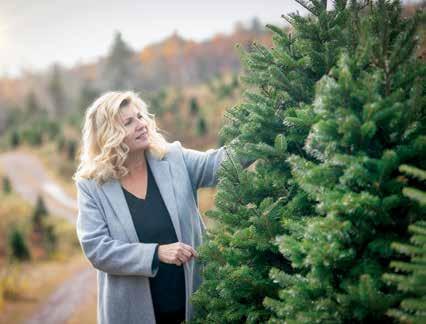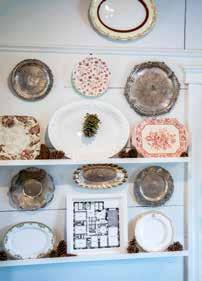
8 minute read
A step back in time for the holidays
English-style kitchen reno adds charm to character-rich, century-old farmhouse
BY SHELLEY CAMERON-MCCARRON
PHOTOS BY STEVE SMITH, VISIONFIRE STUDIOS


One can be forgiven for thinking they’ve stepped into a heartwarming Christmas movie set when entering Tracey and Scott MacKinnon’s 1860s farmhouse kitchen in Marydale, Antigonish County. After all, a glimpse out the back window reveals a barn where staff are busy making Christmas wreaths. A few steps beyond that is a balsam fir Christmas tree operation, where MacKinnon’s guests can wander into countryside scenery, perhaps with a family dog tagging along.
At the heart of the story is the hub of the home, the kitchen — a character-rich, old English-style kitchen that the family recently renovated, finishing in June.
“This is really the centre of the home,” says Tracey, owner of the interior design firm TML Design Studio, and an avid Christmas decorator. (She’s been known to put up as many as seven trees around the rustic two-storey farmhouse!)
Scott runs the family business, Elite Balsam Products, which exports Balsam Fir Christmas trees, wreaths, brush and garland.
“Christmas dinner, Easter dinner, we host it here. We’d all be jammed in,” she says of the couple’s two teenagers and their extended family who gather often in the home where Scott and his three brothers grew up. “It was treacherous,” she jokes. “Now we have so much more room.” The kitchen hadn’t been renovated since 1985. It was brown, small and dark, Tracey says. It was also a big job as it required structural change. So, while the home had updates over the years, it was waiting for its moment. A wall separated the original summer kitchen from a 1970s porch add-on; the ceiling was low, at just over 7.5 feet; and it needed insulation. It had zero. “What it lacks in insulation, it makes up in character,” Tracey jokes. Working with contractor Steve Doyle Construction — who she says was fantastic — they finished the reno in eight weeks. They raised the ceiling, removed the wall, put in a support beam, removed the dark pine cabinets, and added spray foam insulation under the floor, in the wall and the ceiling. “It will make a huge difference for us.”
Tracey MacKinnon in her newly renovated 1860s farmhouse kitchen in Marydale, Antigonish County.
A step back in time for the holidaysAt Home on the North Shore ah! Winter 2022–23 35
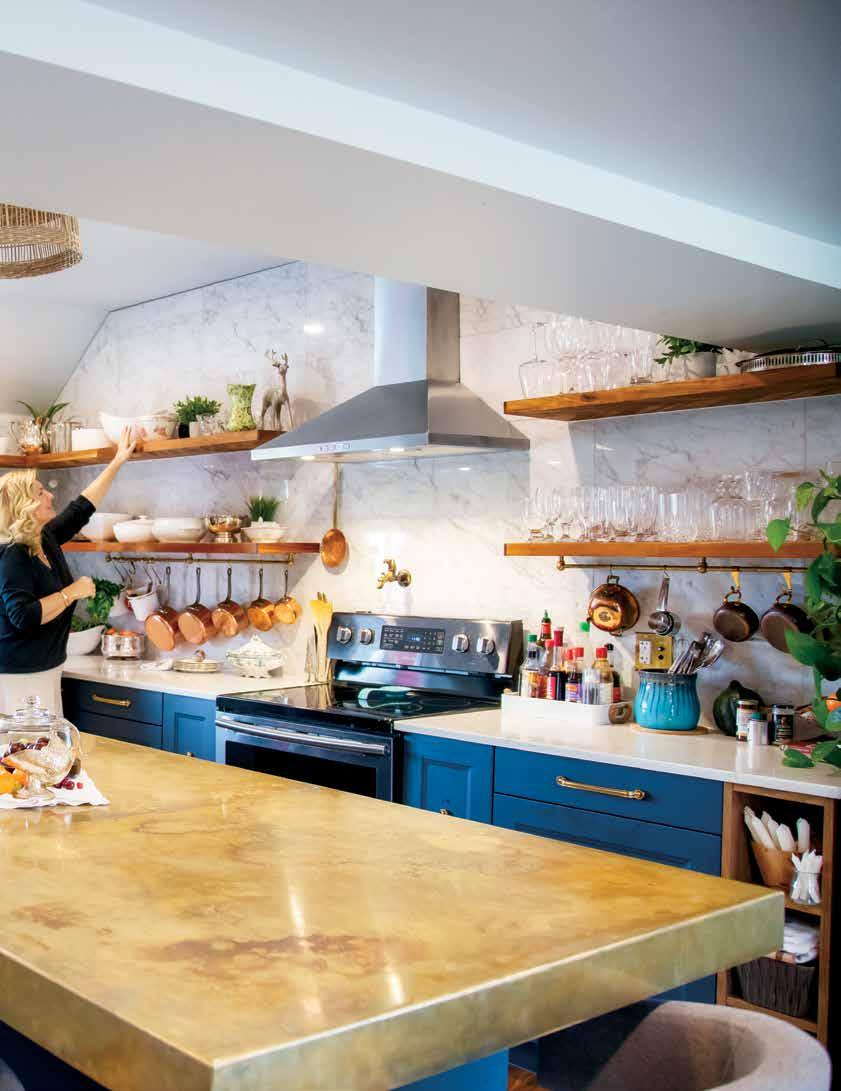
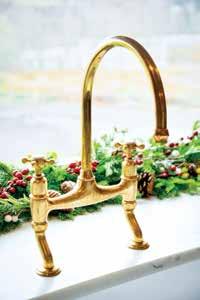
Her design inspiration?

It started with an unlacquered brass English faucet she sourced from Perrin and Roe, which now holds pride of place over a wide sink below a kitchen window. “That old English relaxed look appealed to me,” says Tracey. “As the brass ages, it gets this nice patina.” A kitchen highlight is the large, custom-built unlacquered brass countertop that sits over the island at the room’s centre, surrounded by comfy bar stools. There’s a smaller sink — also with an unlacquered brass faucet — in the island. The custom fabrication arrived in three pieces and was quite shiny. Tracey aged it, using Himalayan sea salt, hydrogen peroxide and vinegar. “It’s called a living finish. It gives it this nice old look, and I don’t have to be precious about the counter. I can change it whenever I want,” she says, explaining how adding salt or hydrogen peroxide melts marks in favour of new ones. They also lowered a window to the countertop level and added a faux wall behind the cupboards to gain a deep countertop. “I wanted that extra space for appliances,” Tracey says, noting the space behind the sink is ideal for flowers, tomatoes and seasonal herbs. It also gives a nice, clean feel, adding to the airy concept, to the farmhouse chic. An apron front sink was on her wish list, while Scott wanted only three things: insulation, a drinks fridge, and a microwave drawer (the appliance is incorporated into the island and off the counter). Their dishes are displayed on open shelving. The couple added a vent hood (something they never had before) and an outdoor garden spigot over the stove to provide the convenience of water there. Copper pots from France trail from brass hanging racks. Sourced second hand, the pots are more than 50 years old. They are functional, but also add aesthetic appeal, she says. Serving ware and china are displayed on a white wall with wide, original planks. Kids’ height measurements are etched into a door frame. Tracey says she was drawn to old-style kitchens that function. The comfortable, relaxed vibe appealed for a home where “it’s shoes-on.” They incorporated blue IKEA kitchen cupboards, island bottom and pantry, personalizing the hardware. This enabled them to spend on faucets, the island countertop, push-button unlacquered brass lights fixtures, and needed structural updates. “It allowed us to do things like putting in the structural beam. That gets costly,” Tracey says. “The floor was old and uneven. We had to put in supports and a subfloor under the wood laminate. A lot of money went into things no one sees.” Long before they started the project, Tracey spent two years planning and sourcing materials as she came upon them. As such, the only COVID-related supply challenge centred around appliances. They kept their original fridge, stove, and dishwasher, although they plan to add an induction range. Scott and Tracey, who met in Halifax, hadn’t planned to live in Antigonish. When Scott’s dad, Lloyd, passed away in 2000, Scott took over the family business. In 2002, the couple moved to the family home, which Scott’s parents had purchased in 1972. Life at a Christmas tree farm is particularly hectic starting in October. But it’s also festive. “I love it. I get the urge to decorate for Christmas,” says Tracey, who keeps the décor classic with white lights, red bows, and greenery. Much greenery. With an almost unlimited supply of balsam fir (“it smells like Christmas”), she goes big, adding wreaths, garland and trees in the living room, the front garden and the upstairs landing. Once she even decorated an upside-down tree hanging from the ceiling.
The kitchen dishes are now displayed on open shelves and copper pots trail from brass hanging racks. Bought secondhand, the pots are more than 50 years old and are both aesthetically pleasing and functional.
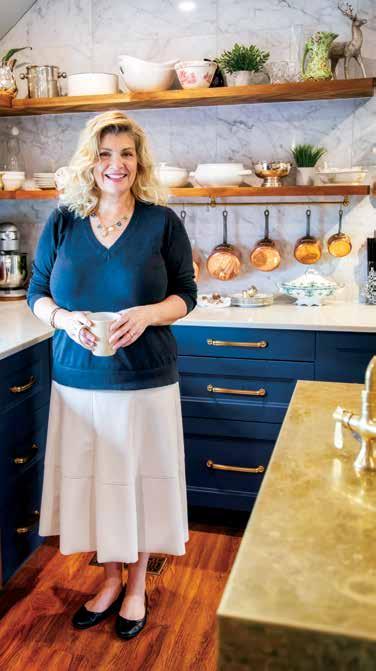
Lights and candles are also everywhere. “I got a real thing for Charles Dickens’ Christmas. I’m a sucker for that,” she says, showing off a Dickens’ Village collection, which lingers (“unlit, so I’m not crazy”) year-round. “Around here, it’s festive, it’s exciting. I look forward to decorating and cooking and everyone coming home.” The farmhouse, with many small rooms, is particularly fun to decorate as she can individualize décor for each, in a house often central for extended family Christmas gatherings. They always managed to make do, hosting everyone in the kitchen, but now, she looks forward to doing it more comfortably. “I’m really glad we have a durable kitchen that can take it.”
First and foremost, if you can manage to avoid an artificial tree, do so, she says. Nothing compares to the look and scent of a real Christmas tree, and a freshcut, properly watered tree should last you throughout the holiday season.
“I often wind a cedar and fir garland down the stair railing, with plenty of pine interspersed for fullness. For drama, a thick rope of garland hung over a doorway and draped on either side, accented with mini-lights and a large statement bow, elevates an entrance.”
Use the greenery as a base for unexpected colour combinations, too. A centrepiece of fir boughs and orange and red roses and mini carnations is both cheerful and warm, and a break from the usual red, white and green.
Stretching your festive décor into winter
If one wants to extend the holiday decorating beyond the New Year, Tracey suggests eliminating anything that’s specifically themed, such as décor featuring reindeer, Santas and snowmen, but keeping the botanical elements.
“Put away those glass balls and candy canes, but keep the seasonally appropriate décor such as greenery, birch logs and white berry branches,” she says. “If it looks like it came from outside, display it until the weather changes!”
A wreath made of balsam fir, pine boughs and pinecones can last on your front door for months. Simply swap out the red ribbon for a classic white or rustic burlap bow.
Additionally, a mantle decorated with cedar branches still looks lush even after you’ve removed the twinkling lights and snow globes. Add some eucalyptus sprigs and one or two ivory candles (safely ensconced in glass, hurricane lamptype holders) and you have a subtle decorative accent that goes beyond Dec. 25.
“Scale back the quantity if you’re prone to a maximalist style, like me,” she says. “Take down the arched swags from the doorways and trailing garland draped on the stair railing but keep some small green or white touches on windowsills or tabletops.”
She also suggests a downsized green wreath inside or one made of multihued pheasant feathers, pinecones or magnolia leaves, which offers an organic touch that still feels decorated but not overdone.
“Finally, keep in mind it’s a cold season here in the Maritimes, so decorate for cosy! Faux-fur throws and cushions, warm blankets draped across a sofa-back and a wicker basket with fire logs at the ready make for a warm and inviting space.”
